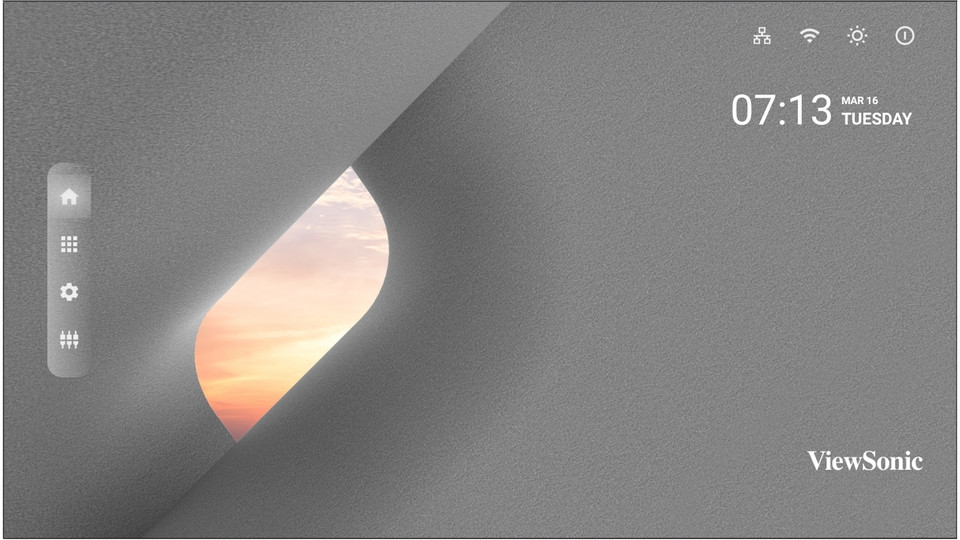























£81,330.45*
- Resolution 1920 x 1080 Full HD
- Max. Brightness 600 cd/m²
- Refresh Rate 3,840Hz
- Aspect Ratio 16:9


Product information
231" All-in-One Direct View LED Display
The ViewSonic LDM231-251 is a state-of-the-art 231-inch All-in-One LED display that enhances the visual and auditory experiences in demanding corporate and educational environments. With an impressive brightness of 600 cd/m², a high contrast ratio of 6,500:1 and a refresh rate of 3,840 Hz, complemented by two 30W speakers, it delivers exceptional clarity and immersive sound for every video, presentation and lecture. The all-in-one design simplifies installation, allowing 2 people to set up the unit within 2 hours, minimising labour costs and downtime. This display utilises Glue-on-Board (GOB) surface treatment technology to achieve an IP54 rating for enhanced protection against shock, dust and moisture. With its ultra-slim 31mm design and 6mm thin bezels, the display offers a premium aesthetic and provides an engaging viewing experience. In addition, the detachable control box enables a screen-to-body ratio of almost 99%, allowing it to fit seamlessly into any room while being easily accessible. It also supports PIP/PBP display and wireless casting, offering more flexibility for collaboration. Thanks to its compatibility with AV control systems, IT staff can also configure the screen remotely.
- 231" seamless large screen with high brightness and powerful speakers
- All-in-one integration for effortless installation
- Collision proof, dustproof and moisture-resistant with GOB surface treatment
- Removable system control box for a minimalist appearance and easy access
- Strong aesthetics with ultra-slim and frameless design
- PIP/PBP display, wireless casting and LAN control possible
Captivating images that shine bright
Experience breathtaking clarity with an impressive brightness of 600 nits, which can be adjusted in 100 levels, and an outstanding contrast ratio of 6.500:1. This screen delivers a captivating, crystal-clear picture that stands out effortlessly even in large rooms with ambient light. With a lightning-fast refresh rate of 3,840 Hz, it effortlessly elevates any presentation to an unrivalled level.

First-class aesthetics with ultra-slim and frameless design
With a 136" diagonal screen size, larger than nine 46" LCD displays combined, this frameless display delivers content seamlessly and without visible edges for a truly immersive visual experience. Its minimalist and sleek design with a thickness of just 31mm exudes sophistication that effortlessly complements any room and interior design.
All-in-one integration for effortless installation
The all-in-one design of the LED display simplifies installation as it requires no configuration of power, control, image stitching and display systems. Simply switch on the display to start operation.

Removable system control box for a minimalist appearance
The system control box easily detaches from the LED display, achieving an impressive 99% screen-to-body ratio that seamlessly integrates the display into any setup. It can also be placed up to 10 metres away from the LED display for flexible access to the control panel.

Seamless collaboration with split-screen modes
Enhance content sharing with intuitive split-screen capabilities. This LED display seamlessly supports picture-by-picture (up to 4 different inputs) and picture-in-picture (a smaller screen within the main display) scenarios in real time, enabling dynamic and versatile collaboration.

Centralised management via LAN control
This LED display is compatible with Crestron and myViewBoard Manager and enables simple and efficient management of configurations with multiple displays from a PC via a LAN connection.
Captivate your audience with powerful audio
Deliver compelling presentations that captivate your audience. The display's two 30 W speaker sets ensure powerful and clear sound, even in large rooms.

Full front panel maintenance
Instead of replacing an entire display for maintenance purposes, users can easily replace any defective part with the electric vacuum suction cup using the hot-swappable front LED modules - regardless of technical knowledge.
Wireless content sharing via mobile devices
Simplify content sharing during presentations and improve collaboration in meetings with multiple presenters. Equipped with built-in 2.4G/5GHz Wi-Fi and the pre-installed vCast app, this display enables seamless wireless sharing of content from one or more mobile devices to the screen simultaneously.

Technical data
| Name | ViewSonic LDM231-251 231” All-in-One Direct View LED Display |
|---|---|
| Article number | 1000030894 |
| GTIN/EAN | 0766907026542 |
| Manufacturer SKU | LDM231-251 |
| Model name | LDM231-251 |
| Brand | ViewSonic |
| Product Type | LED Wall |
| Technology | LCD |
| Resolution | 1920 x 1080 Full HD |
| Diagonal | 231" |
| Aspect Ratio | 16:9 |
| Viewing angle - Horizontal | 170° |
| Viewing angle - Vertical | 170° |
| Contrast Ratio | 6,500 :1 |
| Brightness | 100 cd/m² |
| Max. Brightness | 600 cd/m² |
| Colour depth | 13 Bit |
| Diode type | Surface Mount Device (SMD) |
| run-time | 24/7 |
| Refresh Rate | 3,840Hz |
| Inputs | 1x USB-C , 2x USB-A , 3x Ethernet , 4x HDMI |
| Outputs | 1x HDMI , 2x 3,5mm Jack |
| Features | Picture in Picture |
| Product width | 51.34 cm |
| Product height | 288 cm |
| Product depth | 31 cm |
| Weight | 445.43 kg |
| Colour | Black |
| Delivery contents | Ethernet cable , Power cable , Remote control , mount |
| Condition | New |
| Warranty | 60 Month |
| Warranty type | Onsite Repair Service and support information |
Product safety
| Person responsible for the EU |
|---|
| ViewSonic Technology GmbH |
| Fürst-Leopold-Platz 1 |
| 46284 Dorsten |
| Germany |
| sales-uk@viewsonic.com |



